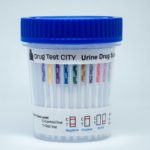
We’ve all heard the stories of a man bringing his wife’s urine to cheat on a drug test and when he asks the doctor about his results the doctor responds “well you’re clean on drugs, but did you know you were pregnant?”. Can drug tests detect gender, or is this an urban legend that is an entertainment trope?
Can Drug Tests Detect Gender?
This is actually a complicated question with many aspects. In the simplest terms a drug test itself cannot detect gender. A drug test only tests for the presence of specific metabolites associated with a specific drug. There are compounds found in urine that can be linked to pregnancies and other gender specific conditions.
However urine tests are widely available that detect hCG (human chorionic gonadotropin), a hormone that is produced by the placenta of pregnant women. Many of our clients have a need for testing women for pregnancy because the type of treatment and care changes for a patient that is pregnant. It is relatively cheap to add an hCG strip to testing.

In cases where drug tests are sent to the lab a gas chromatography and mass spectrometry instrument breaks down the sample into all its components. For confirmations a lab technician will focus on the analyte associated with the positive test strip, but all of the compounds are identified. A high level of hCG would be recognized fairly quickly.
So it is true that drug testing would identify pregnancy in cases when providers test for pregnancy or samples are sent to a lab. The assays found in drug test cups and used in laboratory immunoassay tests do not detect hCG though.
What Are the Differences in Men and Women’s Urine
In the rare case a lab technician or medical review officer suspects a subject has used a urine sample from someone of the opposite sex the sample can be put through additional analysis to support their suspicions. Even though a drug test itself cannot determine gender, other tests can indicate gender.
The biggest differences in each sex’s urine are trace hormones, but there are indicators that may cause a lab technician to become suspicious and investigate further.
Women
- Women’s urine can contain hCG (the analyte used to detect pregnancies).
- Women’s urine can be contaminated by blood during menstruation.
Men
- Men process alcohol differently. Higher concentrations of dehydrogenaze are present after consuming alcohol.
- Men have higher muscle mass which can increase creatinine levels.
- Male samples can contain traces of sperm or pre ejaculate, however females can too for 8-12 hours after sex.
Foreign matter such as blood and semen are good indicators of gender, but are far from definite because men can have blood in their urine and women can have male semen in their urine after sex.
The easiest hormone to identify a person’s gender in urine is testosterone. Men produce less testosterone as they age, but will always excrete significantly more testosterone in their urine. Marijuana has been shown to suppress the production and secretion of testosterone and other androgens. A study conducted by the Worcester Foundation for Experimental biology found that men excrete 28-250 μg of testosterone in their urine, while women excrete 2.4-8μg.
Testosterone Levels in Urine
| Sex / Age | AVG Testosterone Levels |
|---|---|
| Male 18-28 | 171 μg (range 65–250) |
| Male 30-35 | 89 μg (range 45–150) |
| Male 42-55 | 81 μg (range 28–159) |
| Female 23-37 | 6 μg (range 2.4–8) |
Can Drug Blood & Hair Drug Tests Detect Gender?
It is almost impossible to adulterate or substitute hair or blood samples during a drug test because a subject has to physically present themselves to have samples taken. A technician will confirm the identity of the subject at the time of sample donation. Any anomalies that indicated a different gender would be investigated as a health issue instead of possible tampering.
However, the same hormones that are present in urine are present in a person’s blood, and DNA from human hair can be used to determine a person’s gender.
Hair samples can give an indication of gender simply by the length and treatment when examined under a microscope, but nuclear or mitochondrial DNA would be needed to determine gender with a hair sample definitely.
Considerations When Testing Different Genders
Even though the basic mechanisms of how a drug test works is the same whether you are testing a male or female, there are some differences you may want to account for. For example women process alcohol slower than men. It would be easier for a female to have some drinks at night and still have alcohol passing through their system the next morning.
Another consideration is that women have a much higher body fat percentage than men. A healthy middle aged male has a body fat percentage of 20% while a healthy female of the same age has a body fat percentage of 30%. Drugs or metabolites that bind to fatty tissues can be detected longer in an individual with a higher body fat content.
| Gender | Body Type | BF % Age 20-39 | BF % Age 40-59 | BF % Age 60-79 |
|---|---|---|---|---|
| Male | Underweight | <8% | <11% | <13% |
| Male | Normal | 8%-20% | 11%-22% | 13%-25% |
| Male | Overweight | 20%-25% | 22%-28% | 25%-30% |
| Male | Obese | >25% | >28% | >30% |
| Female | Underweight | <21% | <23% | <24% |
| Female | Normal | 21%-33% | 23%-34% | 24%-36% |
| Female | Overweight | 33%-39% | 34%-40% | 36%-42% |
| Female | Obese | >39% | >40% | >42% |
This doesn’t mean that a woman that you should alter results for females, but there are many instances when this knowledge is useful. For example after a failed drug test you can expect women to have a slightly longer detection time for drugs that have an affinity for fatty tissue. It can help with scheduling retests, confirming patient statements, and advising clients about detection times.
Will You Get Caught if You Use Urine From the Opposite Sex to Cheat a Drug Test?
Using urine from the opposite sex to pass a drug test will go unnoticed in the vast majority of drug screens because assays only detect the metabolite they are designed for. A male using a pregnant female’s urine would increase the likelihood of being caught because of the hCG content.
However, you are much more likely to be caught substituting urine by a witness during screening, a cold temperature strip, suspicion from staff, or a number of other discrepancies that are present when you substitute someone else’s urine for a sample.

